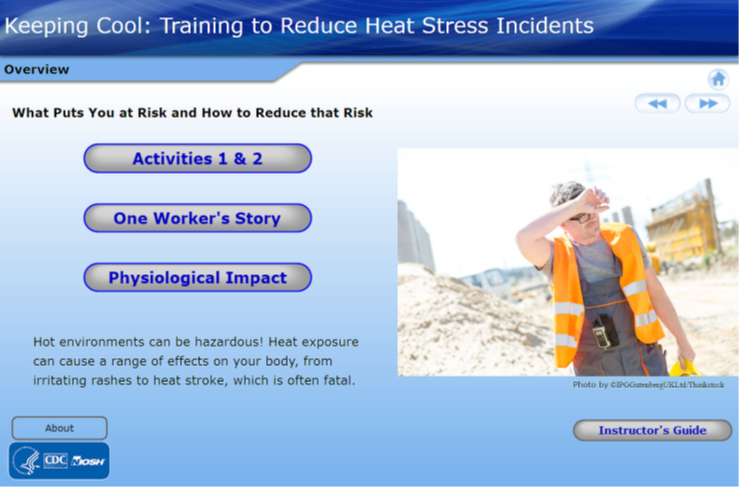Training to Reduce Heat Stress Incidents Among Miners
Posted on by
Workers who are exposed to occupational heat stress (i.e., the combination of heat from environment factors, metabolic heat, and clothing/PPE) may be at risk for heat-related illnesses and injuries. Heat-related illnesses may include heat stroke, heat exhaustion, heat cramps, heat rashes, and rhabdomyolysis. Injuries with heat as a factor may also occur, such as falls when someone becomes dizzy or slips on sweat puddles on floors. All miners should be trained on heat stress, a growing issue as underground mines extend to hotter, deeper areas and surface mines experience more frequent and intense heat waves. To prepare miners for the growing risk of heat stress, NIOSH recently published a free online training module Keeping Cool: Training to Reduce Heat Stress Incidents. The training module improves miners’ understanding of their risk factors for heat illness and how to reduce those risks.
The module includes two activities that promote small group discussions of risk factors and signs and symptoms of heat illness. Rather than lectures, it focuses on case-based discussions that allow participants to pull from prior knowledge of heat stress and add to that knowledge through focused questions that require them to engage in active learning. A series of fact sheets are available for printing and allow participants to search for specific information to answer discussion questions.
The module is designed to allow any person at a mine site to provide the training rather than requiring a trainer with expertise in heat stress. An instructor guide includes information on how to set up and guide each activity, discussion questions with answers, and materials to print. Because various mines have different time constraints, the modular design allows for flexibility, with training that can be given in small sections or provided during a longer training event. For questions on this heat stress training module, please use the comment section below or e-mail MinerHealth@cdc.gov. If you have used the training, please provide your feedback below.
Kristin Yeoman, MD, MPH, is a medical officer in the NIOSH Spokane Mining Research Division.
Brianna M. Eiter, PhD, is a Research Health Scientist and Team Lead in the NIOSH Spokane Mining Research Division.
Alex Johnson, MPH, is a Health Communication Specialist in the NIOSH Spokane Mining Research Division.
Posted on by

